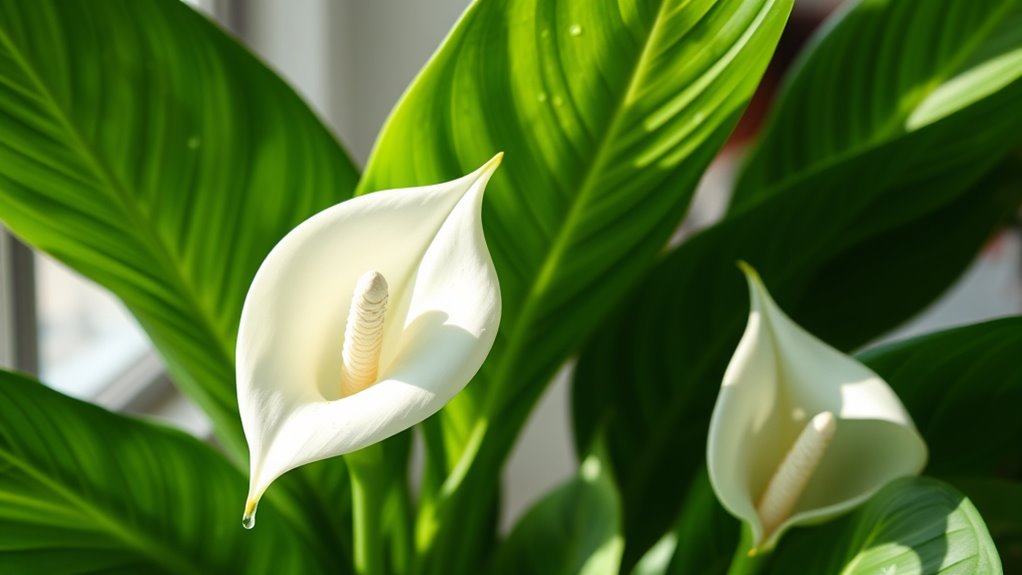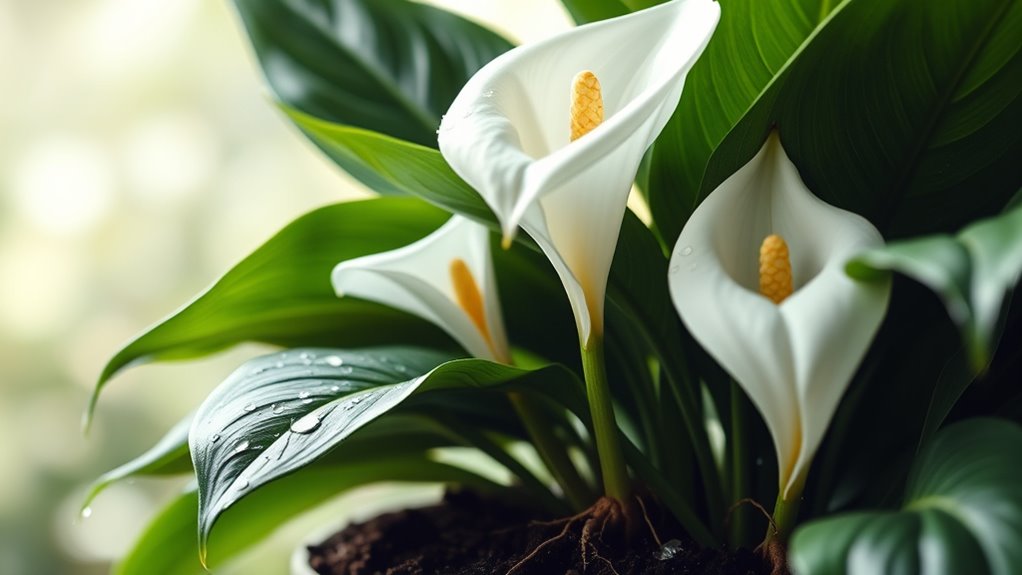To guarantee your Peace Lily produces beautiful blooms, keep the soil consistently moist but not soggy by watering when the top inch feels dry, using room temperature water. Regularly inspect for pests, wipe leaves, and maintain good air circulation to prevent infestations. Avoid overwatering or sudden temperature changes, and stick to a steady care routine. For more expert tips on optimizing your plant’s health and blooms, continue exploring ways to care for your Peace Lily.
Key Takeaways
- Keep soil consistently moist but not soggy, watering thoroughly when the top inch feels dry.
- Provide bright, indirect light to encourage healthy growth and vibrant blooms.
- Maintain stable temperatures and avoid drafts to reduce stress and promote flowering.
- Regularly inspect leaves for pests and wipe with a damp cloth to prevent infestations.
- Use room temperature water and ensure good air circulation around the plant.

Caring for a peace lily is straightforward, making it an ideal plant for both beginners and experienced gardeners. To keep your plant healthy and promote its beautiful blooms, you need to pay attention to its watering schedule and take steps for pest prevention. The peace lily prefers consistently moist soil, but it doesn’t thrive in soggy conditions. You should water it when the top inch of soil feels dry to the touch, usually about once a week. During warmer months, you might need to water more frequently, especially if your home is dry or heated. Conversely, in cooler seasons, reduce watering slightly to prevent overwatering, which can lead to root rot. When watering, do so thoroughly until excess water drains from the pot’s bottom. This guarantees the roots get enough moisture without sitting in water, which is essential for healthy growth. Using room temperature water is best to avoid shocking the roots and to promote steady moisture absorption. Proper watering also supports the plant’s filtration system, helping to reduce dust and allergens on the leaves. Pest prevention is also indispensable for maintaining a thriving peace lily. Common pests like spider mites, mealybugs, and aphids can invade the plant, causing damage and hindering blooming. Regularly inspect your peace lily’s leaves and stems, especially the undersides, where pests tend to hide. If you notice tiny webs, sticky residue, or discolored spots, act quickly. You can wipe the leaves with a damp cloth or use a gentle insecticidal soap to keep pests at bay. Ensuring good air circulation around your plant also discourages pests from settling in. Avoid over-fertilizing, as overly rich soil can attract unwanted insects, and keep the plant away from drafts or sudden temperature changes that stress the plant and make it more vulnerable. Proper watering plays a role here too—overly moist conditions can foster fungal issues or pests, while under-watering stresses the plant, making it more susceptible to infestations. Consistency is key; stick to your watering schedule and regularly check for pests to prevent problems before they escalate.
Frequently Asked Questions
How Often Should I Repot My Peace Lily?
You should repot your Peace Lily every 1-2 years or when it outgrows its current container. During repotting, check your watering schedule to guarantee the soil stays moist but not soggy. Use well-draining soil to meet its soil requirements and promote healthy roots. Repotting helps refresh the soil, prevent rootbound conditions, and support vibrant growth, leading to more beautiful blooms.
Can Peace Lilies Thrive Outdoors Year-Round?
Peace lilies can perform perfectly outdoors during warm weather, thriving with ample outdoor sunlight and seasonal growth cycles. However, you need to protect them from harsh frosts and cold conditions, as they don’t thrive year-round outside. When temperatures dip below 60°F, bring your plant indoors. With proper timing, outdoor sunlight, and seasonal care, your peace lily will flourish beautifully during suitable months.
What Are Common Pests That Affect Peace Lilies?
You might notice pests like spider mites, aphids, or mealybugs on your peace lily. Pest identification helps you spot these issues early. To control them, try organic pest control methods like neem oil or insecticidal soap, which are effective and safe. Regularly inspect your plant, especially the undersides of leaves, to keep pests at bay and guarantee your peace lily stays healthy and vibrant.
How Do I Prune My Peace Lily Properly?
Ironically, pruning your peace lily might seem like unnecessary flower maintenance, but it’s essential for vibrant blooms. Use sharp scissors or pruning shears to trim dead or yellow leaves at the base, encouraging new growth. Follow proper pruning techniques by removing only damaged foliage, avoiding healthy leaves. This keeps your plant looking tidy and promotes flowering. Regular pruning ensures your peace lily stays healthy and beautiful, making flower maintenance a breeze.
Is It Safe to Have Peace Lilies Around Pets?
You might wonder if peace lilies are safe around pets. While they’re beautiful, they pose a risk because of pet toxicity. If your pet chews on the plant, it can cause symptoms like vomiting or skin irritation. To guarantee pet safety, keep peace lilies out of reach or consider alternative plants. Always monitor your pets and consult your vet if you suspect poisoning. Your pet’s safety should come first.
Conclusion
Taking good care of your peace lily guarantees vibrant blooms and a healthy plant. Remember, overwatering can cause root rot, so keep the soil moist but not soggy. Did you know that peace lilies can filter indoor air pollutants by up to 50%, making your space healthier? With proper watering, lighting, and occasional fertilizing, you’ll enjoy their beautiful white flowers year-round. Keep these tips in mind, and your peace lily will thrive beautifully!









